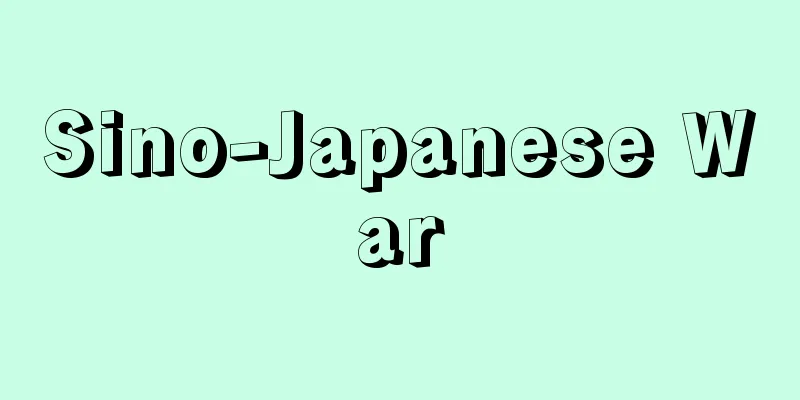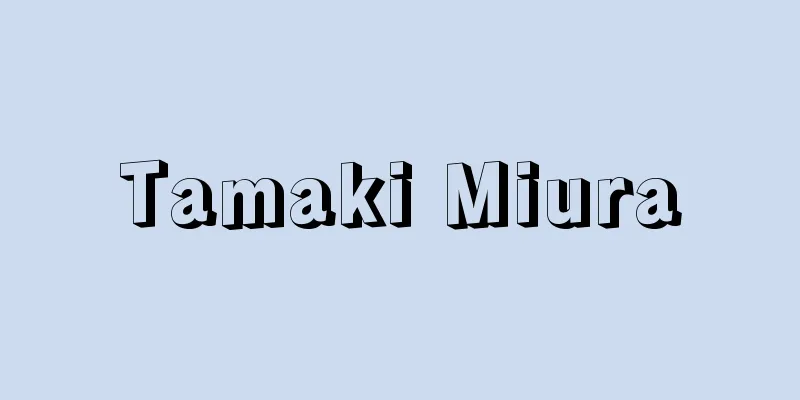Sino-Japanese War

|
An all-out war between Japan and China that began with the Marco Polo Bridge Incident in July 1937 (Showa 12) and ended with Japan's surrender in August 1945. When referred to as the Fifteen-Year Sino-Japanese War, the starting point is the Manchurian Incident in September 1931. In China, it is generally called the War of Resistance against Japan, but it is also sometimes called the Second Sino-Japanese War. The Sino-Japanese War was the spark that ignited World War II in East Asia and remained an important part of the conflict throughout. [Yasui Miyoshi] BeginningThe Marco Polo Bridge incident on July 7, 1937 was the ignition point, but Japan had many opportunities to resolve the issue locally, as it was initially called the "North China Incident." However, the government, military, and media were led by the idea of expanding the scope of the conflict, such as forcing China to surrender in one blow or sending more troops to "punish" China, and the conflict slowly progressed to an all-out war. Army Minister Hajime Sugiyama and others said that "it will be over in about a month," but this was a complete miscalculation of China's resistance. Based on the "Statement on the Dispatch of Troops to North China" on July 11, Japan, in addition to the troops it had sent from Korea and Manchuria, sent three additional divisions from Japan at the end of the same month and seized the areas around Peiping (Beijing) and Tianjin in one fell swoop. While the Chinese Communist Party was calling for an immediate war of resistance, Chiang Kai-shek of the Nationalist government, who still held out hope for peace, finally announced on the 29th that they had reached the "final crossroads" (a situation in which peace had become hopeless and war of resistance was inevitable). On August 9th, following the Lieutenant Oyama Incident (in which Lieutenant Oyama Isao of the Marine Corps was shot and killed by Chinese security forces near Shanghai's Hongqiao Airport), Japan sent troops into the Shanghai area one after another, and on the 13th, the country entered into a state of war, sparking the Second Shanghai Incident. [Yasui Miyoshi] Fully integratedOn August 14, the Nationalist government issued the "Declaration of Self-Defensive Resistance," and the following day, the 15th, the Chinese Communist Party proposed the "Ten Principles for Resisting Japan and Saving the Nation." On the same day, Japan also organized an expeditionary force to Shanghai, and issued the "Government Statement on the Marco Polo Bridge Incident," which could be considered a declaration of war, finally embarking on all-out war, and on September 2nd, the name of the "North China Incident" was changed to the "China Incident." Meanwhile, the Soviet Union signed the Sino-Soviet Non-Aggression Pact with the Nationalist government on August 21 and began providing arms and ammunition, but the attitude of the United States and Britain toward Japan at this point was extremely conciliatory. During this time, cooperation between the Kuomintang and the Communist Party progressed rapidly, and in August the Red Army in North China was reorganized into the Eighth Route Army of the National Revolutionary Army and deployed to the front lines (the Red Army in Central China was reorganized into the New Fourth Army in October). In September the Shaan-Ganning (Shaanxi, Gansu, Ningxia) Border District Workers' and Peasants' Government was renamed the Shaan-Ganning Border District Government, and later that month the Chinese Communist Party announced the second Kuomintang-Communist cooperation and the establishment of an anti-Japanese national united front. The Kwantung Army entered "Mengjiang" (Chahar and Suiyuan regions) without encountering any significant resistance, occupying Zhangjiakou at the end of August, Datong in September, Suiyuan and Baotou in October, and in November forming a puppet organization, the Mengjiang United Committee, in Zhangjiakou. In northern China, the North China Area Army was formed on August 31st, and although it was defeated at Pingjiang Pass, it expanded its occupied territory to Baoding in September, Taiyuan in November, and Jinan in December, and in the same month established a puppet government, the Provisional Government of the Republic of China, in Beiping. In central China, the Japanese faced fierce resistance from the Chinese side, and by the time they occupied Shanghai in November, the number of dead and wounded on the Japanese military had reached 40,000. On the 7th of the same month, the China Area Army was formed, and in December, Nanjing was occupied. At this time, the Japanese army committed a massacre. There is a theory that this incident "resulted in at least 200,000 Chinese military and civilian casualties" (Hora Tomio, The Definitive Edition of the Nanjing Massacre). This incident drew harsh criticism from international opinion, and further raised China's sense of resistance. The Nationalist government had already moved its capital from Nanjing to Chongqing in November, and Japan's initial plan to force China to surrender by occupying Nanjing was not realized. However, after the occupation of Nanjing and the establishment of the Provisional Government, Japan terminated the peace efforts that it had been pursuing through the mediation of German ambassador to China, Trautmann, in January 1938, and on the 16th of the same year, it issued the First Konoe Statement, which stated, "From now on, we will not treat the Nationalist government as an opponent," and thus closed the door to a negotiated settlement. In February, the Central China Expeditionary Army was organized, and in March, a puppet government called the Republic of China Restoration Government was established in Nanjing. Contrary to the policy of "non-expansion of the war front," after suffering a defeat at Taierzhuang in the same month, they captured Xuzhou in May, Wuhan in October, and Guangzhou, expanding the front line to the middle reaches of the Yangtze River and into southern China. [Yasui Miyoshi] Endurance BattleIn just over a year, the Japanese army occupied most of China's major cities and transportation routes, but this was only a "point and line" of control, and they were unable to control the vast rural areas or the interior areas such as Sichuan Province. The front line had stretched out and the strength to carry out any larger-scale operations was weak. The Japanese army therefore placed emphasis on securing the occupied territories and announced a policy of gradually reducing its military strength, but this was difficult to carry out. On the other hand, the Chinese side had not yet developed the strength to launch an all-out counterattack. Thus, a military balance was reached and the war became a war of attrition. In November 1938, Japan revised its denial of the Nationalist government and issued the Second Konoe Statement, which advocated the formation of a "New Order in East Asia." With no prospect of a military solution in sight, Japan had no choice but to end the war through political maneuvering. Japan had already created a provisional government and a restoration government through military power, but the people who joined these governments were not people who could gain the support of the Chinese people. Therefore, they allowed Wang Jingwei, a pro-Japanese figure in the Kuomintang, to "escape" from Chongqing, and established the "Nationalist Government of the Republic of China" in Nanjing in March 1940. Prior to this, the China Expeditionary Army General Headquarters was established in September 1939 "to supervise military and political operations, and to promote the establishment of the Wang regime and the Chongqing operation" (National Defense Training Institute War History Department, "Security War in North China 1"). Wang raised the flag of the Kuomintang, believed in the Three Principles of the People, and proclaimed his succession to Sun Yat-sen, but the government was still a puppet of Japan, and the Chinese despised them as "traitors to the nation" and sought to overthrow them. Japan signed the "Treaty on Basic Relations between Japan and the People's Republic of China" with the Wang government in November 1940, aiming to resolve the war, but this government did not represent the Chinese people and had the power to do so, so it was a complete waste of time. [Yasui Miyoshi] Liberated AreaWith the exception of the Hundred Regiments War in 1940, the Chinese Communist Party mainly used guerrilla tactics to fight the Japanese army while building and expanding the liberated areas. The liberated areas were aimed at as model areas for the anti-Japanese national united front. The rising up of individual people, mainly peasants, was the deep source of China's resistance. In addition to fighting the regular army, the Japanese army had to confront such a wide range of people. From 1941 to the following year, the liberated areas were forced to shrink significantly due to the fierce attacks of the Japanese army accompanied by the Three Alls policy of killing all (kill all), burning all (burn all), and seizing all (take all) and the crackdown of the Kuomintang army. However, by the spring of 1945, the liberated areas had grown to a total of 19, covering an area of about 1 million square kilometers and a population of about 100 million. During this period, Mao Zedong published "On New Democracy" (January 1940), and the material and human base of the Chinese Communist Party was formed in the liberated areas. [Yasui Miyoshi] Sino-Japanese relationsAlthough relations between the Kuomintang and the Communist Party had been relatively smooth, various contradictions and conflicts began to surface around the time of the loss of Wuhan (October 1938). This was because the Kuomintang began to fear the expansion of the Communist Party's influence, such as the expansion of liberated areas, in addition to Japan's political maneuvering against the Kuomintang. After 1939, the Kuomintang strengthened restrictions on the activities of the Communist Party of China, even resorting to armed suppression. The biggest incident was the Annan Incident in January 1941 (an attack on the New Fourth Army by the Kuomintang forces in southern Anhui Province). At this time, relations between the Kuomintang and the Communist Party deteriorated significantly, with the Communist Party of China temporarily refusing to attend the National Assembly, but the situation did not return to the full-scale civil war it had been in the past. [Yasui Miyoshi] Logistics BaseJapan sought to escape the quagmire of the Sino-Japanese War by advancing south. The German army's lightning victory in Europe gave impetus to this direction. On December 8, 1941, Japan entered the Pacific War. By this time, Japan had already suffered approximately 180,000 deaths and 430,000 wounded and sick in the war with China. Although Japan's victory in the first battle of the Pacific War was glorious, it suffered a major defeat in the Battle of Midway in June 1942, losing four of its main aircraft carriers. As soon as hostilities with the United States and Britain began, Japan was forced to withdraw part of its forces from the Chinese front and transfer them to the south, and the possibility of a military victory over China became increasingly remote. Japan mobilized China's abundant resources in the fight against the United States and Britain, and turned China into a logistical base for the "Greater East Asian War." Meanwhile, just as the final focus of Japan-US negotiations was the complete withdrawal of Japanese troops from China (Hull Note), the United States and Britain made their support for China clear around the time the war began, and began to provide full-scale military aid to the Nationalist government through aid routes to Chiang Kai-shek, such as the Burma Route. [Yasui Miyoshi] SurrenderJapan attempted several large-scale operations, such as the attack on Yichang, a key point in the middle reaches of the Yangtze River, the air raids on Chongqing and Chengdu (1940), the Battle of Central China (1941), the Changsha Operation (1941-1942), the Zhejiang Operation (1942), and the Mainland Breakthrough Operation (1944), but was ultimately unable to force China to surrender. This was due to the long-term resistance of the Chinese people, the assistance of the Soviet Union, the United States, and the United Kingdom, as well as international support from the Japanese anti-war movement in the liberated areas and Kuomintang areas, and the anti-Japanese struggle of Koreans. Then, in August 1945, Japan finally surrendered after the dropping of two atomic bombs by the United States and the entry of the Soviet and Mongolian armies into the war. The surrender document was signed on September 2nd, but in China the following day, the 3rd, is celebrated as "Victory Day in the Anti-Japanese War." The China Expeditionary Army surrendered to the Chinese Army on September 9th in Nanjing, and the 10th Army surrendered to the Chinese Army on October 25th in Taipei (the Kwantung Army surrendered to the Soviet Far East Army). Thus, all of the approximately 2 million Japanese troops in China surrendered. The number of Japanese troops deployed in China (including Manchuria and Taiwan) who were killed in battle reached approximately 540,000. "Manchukuo" and the "Republic of China" in Nanjing collapsed with Japan's surrender. The colony of Taiwan, the Penghu Islands, and the leased territory of Kwantung Leased Territory were all returned to China. Most of the approximately 2 million ordinary Japanese who had traveled to China returned home (after the Soviet Union entered the war against Japan, approximately 180,000 Japanese died in Manchuria from battles, attacks, disease, starvation, suicide, etc.). Thus came an end to the history of invasion and colonial rule of China that had continued since the Sino-Japanese War of 1894-1895 (Meiji 27-28). [Yasui Miyoshi] Crushing VictoryAlthough China was victorious, it is said that 10 million lives were lost and that it suffered $50 billion in material damage (Shen Junru, "Regarding the Arrest and Punishment of War Crimes," September 1951). Approximately 40,000 Chinese were forcibly taken to Japan to make up for the labor shortage. In Taiwan, policies to turn people into Imperial subjects, such as forcing them to use Japanese and Japanizing their names (changing their surnames and given names), were implemented, and tens of thousands of people were mobilized as Japanese soldiers in the "Greater East Asia War." In "Manchukuo," too, ethnic oppression and discrimination against the Chinese were carried out under the slogan "Harmony among the five races, a land of kingly happiness." One typical example was the live animal experiments carried out by the Kwantung Army's "731" Ishii Special Forces. Japan concluded the Japan-China Peace Treaty in April 1952 with the Chiang Kai-shek regime, which had fled to Taiwan following the Chinese Revolution, but it was not until the Japan-China Joint Communiqué of September 29, 1972 that the end of the state of war between Japan and the People's Republic of China was declared. This was 27 years after the end of fighting. [Yasui Miyoshi] "The Road to the Pacific War 3 and 4" (1962, 1963, Asahi Shimbun Publishing), edited by the Pacific War Causes Research Division of the Japan Association of International Relations" ▽ "The Sino-Japanese War" by Usui Katsumi (1967, Chuokoron Shinsho )" ▽ "History of the Pacific War, 6 volumes edited by the Historical Studies Research Group (1971-1973, Aoki Shoten)" ▽ "History of the Sino-Japanese War" by Hata Ikuhiko (1972, Kawade Shobo Shinsha)" ▽ "The Fifteen-Year War" by Ito Takashi (Japanese History 30, 1976, Shogakukan)" ▽ "A Study of the History of the Pacific War" by Fujiwara Akira (1982, Aoki Shoten)" ▽ "The Full-Scale Sino-Japanese War" by Fujiwara Akira (Showa History 5, 1982, Shogakukan)" ▽ "The Opening of the Fifteen-Year War" by Eguchi Keiichi (Showa History 4, 1982, Shogakukan) "The Pacific War" by Junichiro Kizaka (Showa History 7, 1982, Shogakukan)" "Modern History Materials: Sino-Japanese War 1-5" edited by Toshihiko Shimada, Masao Inaba, Katsumi Usui, et al., 5 volumes (2004, Misuzu Shobo) [References] | | |Kwantung | | | |Kuomintang- | | | | |Chinese Party|Chinese Kuomintang|Sino | | | | |Treaty |Japan | | | |Marco©Shogakukan "> China and Japan during the Sino-Japanese War (1937-1919) ©Shogakukan "> The influence of the liberated areas extended during the Second Sino-Japanese War... Source: Shogakukan Encyclopedia Nipponica About Encyclopedia Nipponica Information | Legend |
|
1937年(昭和12)7月の盧溝橋(ろこうきょう)事件に始まり、1945年8月日本の降伏で終わった、日本と中国との全面戦争。日中十五年戦争という場合は、1931年9月の満州事変を起点とする。中国では一般に抗日戦争とよぶが、第二次中日戦争という言い方もある。 日中戦争は、第二次世界大戦の東アジアにおける導火線であり、一貫してこの大戦の重要部分を占めた。 [安井三吉] 発端1937年7月7日の盧溝橋事件が発火点であるが、当初「北支事変」と称したように、日本にとり局地的解決の機会は何度もあった。しかし、一撃で中国を降伏させる、あるいは、「膺懲(ようちょう)」のために増派せよという拡大論が政府、軍部、マスコミをリードし、ずるずると全面戦争へと進んでいった。杉山元(はじめ)陸相などは「1か月ぐらいでかたづく」といっていたが、それは中国の抗戦力を完全に見誤るものであった。日本は7月11日の「華北派兵声明」に基づき、朝鮮、満州から送り込んでいた部隊に加え、同月末さらに日本から増派した3個師団をもって北平(ペイピン)(北京(ペキン))、天津(てんしん)一帯を一挙に制圧した。即時抗戦を主張する中国共産党に対し、なお和平に賭(か)けていた国民党政府の蒋介石(しょうかいせき)も、ついに29日、「最後の関頭」(和平が絶望的となり、抗戦の避けられない事態)に至ったことを表明した。8月9日、大山中尉事件(海軍陸戦隊の大山勇夫中尉が上海(シャンハイ)の虹橋(こうきょう/ホンチャオ)飛行場付近で中国の保安隊に射殺された事件)が起こるや、日本は上海一帯にも続々と部隊を投入、13日ついに交戦状態に突入、上海事変(第二次)を起こすに至った。 [安井三吉] 全面化8月14日、国民政府は「自衛抗戦声明書」を発表、翌15日中国共産党も「抗日救国十大綱領」を提起した。日本も同日、上海派遣軍を編成する一方、戦争宣言ともいうべき「盧溝橋事件に関する政府声明」を発表、ついに全面戦争へと踏み切り、9月2日には「北支事変」の呼称を「支那(しな)事変」と改めた。 他方、ソ連は8月21日国民政府と「中ソ不可侵条約」を結び、武器・弾薬の援助に乗り出すが、米・英の日本に対する態度は、この時点ではきわめて宥和(ゆうわ)的なものであった。この間、国共間の合作態勢は急速に進み、8月、華北の紅軍は国民革命軍の八路(はちろ)軍に改編され、前線に出動した(華中の紅軍は10月新四軍に改編)。9月陝甘寧(陝西(せんせい)・甘粛(かんしゅく)・寧夏(ねいか))辺区労農政府も陝甘寧辺区政府と改称、同月下旬中国共産党は第二次国共合作と抗日民族統一戦線の成立を宣言した。「蒙疆(もうきょう)」(察哈爾(チャハル)・綏遠(すいえん)地方)に入った関東軍は、大きな抵抗も受けず、8月末張家口(ちょうかこう)、9月大同、10月綏遠、包頭(パオトウ)を占領、11月張家口に傀儡(かいらい)組織蒙疆連合委員会を組織した。華北では、8月31日北支那方面軍が編成され、平型関(へいけいかん)で敗北したものの、9月保定(ほてい)、11月太原(たいげん)、12月済南(さいなん)と占領地を拡大、同月、北平に傀儡政権中華民国臨時政府をつくった。華中では、中国側の激しい抵抗を受け、11月上海を占領したときには、日本軍の戦死傷者は4万に達していた。同月7日中支那方面軍が編成され、12月南京(ナンキン)を占領した。このとき日本軍は大虐殺事件を引き起こした。この事件で「二十万を下らない中国軍民の犠牲者が生じた」(洞富雄(ほらとみお)著『決定版南京大虐殺』)との説もある。この事件は国際世論の厳しい批判を招き、中国の抗戦意識を一段と高めるものとなった。国民政府は11月すでに首都を南京から重慶(じゅうけい)に移しており、南京占領によって中国を屈服させるという日本の当初の企図は実現しなかった。しかし南京占領、臨時政府の成立をみた日本は、1938年1月、ドイツの駐華大使トラウトマンを仲介にして進めていた和平工作を打ち切り、同16日「爾後(じご)国民政府ヲ対手(あいて)トセズ」という同政府「抹殺」の第一次近衛(このえ)声明を発表するなどして、交渉による解決の道を自ら閉ざした。2月には中支那派遣軍が編成され、3月南京に傀儡政権中華民国維新政府を樹立した。「戦面不拡大」の方針とは裏腹に、同月台児荘(たいじそう)で敗北するや、5月徐州(じょしゅう)、10月武漢(ぶかん)、広州(こうしゅう)をも攻略、戦線を揚子江(ようすこう)中流、華南にまで拡大した。 [安井三吉] 持久戦1年余の間に日本軍は、中国の主要都市と交通路のほとんどを占領したが、それはいわば「点と線」の支配にすぎず、広大な農村や四川(しせん)省などの奥地は支配できなかった。戦線は延び切り、これ以上大規模な作戦を展開する力は乏しくなっていた。そこで日本軍は占領地確保に重点を置き、兵力漸減の方向を打ち出すが、その実行は困難であった。他方中国側にも、全面的反攻に出るだけの力はまだ形成されていなかった。こうして軍事的均衡に至り、戦争は持久戦となった。 1938年11月、日本は国民政府否認を改め、「東亜新秩序」形成を提唱する第二次近衛声明を発表した。軍事的解決の見通しがたたない以上、日本には政治工作によって戦争収束を図るしか道はなくなっていた。すでに日本は、臨時政府、維新政府などを軍の力でつくりあげていたが、これらの政府に加わった者は中国人の支持を得られるような人物ではなかった。そこで、国民党親日派の大物汪兆銘(おうちょうめい)を重慶から「脱出」させ、1940年3月南京に「中華民国国民政府」を樹立させた。これに先行して、1939年9月「軍事及び政治工作を統轄し、汪政権樹立工作、他方での重慶工作を促進するため」(防衛研修所戦史室著『北支の治安戦1』)支那派遣軍総司令部が設置されている。汪は、国民党の旗を掲げ、三民主義を信奉、孫文(そんぶん)の継承をうたったが、日本の傀儡政権であることに変わりなく、中国人は彼らを「漢奸(かんかん)」(民族の裏切り者)とさげすみ、その打倒をねらった。日本は汪政権と1940年11月「日華基本条約」なるものを結び、戦争解決を企図したが、この政権は中国の国民を代表し実力をもつ政権ではなかったから、それはまったくの徒労に終わった。 [安井三吉] 解放区中国共産党は1940年の百団大戦などを例外とし、主として遊撃戦術を駆使して日本軍と戦いつつ、解放区を建設、拡大していった。解放区は抗日民族統一戦線の模範地域とすることが目ざされた。農民を主体としたひとりひとりの民衆の立ち上がりが、中国の抗戦力の奥深い源泉であった。日本軍は、正規軍との戦いのほか、このような広範な人々と対決しなければならなかった。解放区は、1941年から翌年にかけて、殺し尽くす(殺光)、焼き尽くす(焼光)、奪い尽くす(搶光(そうこう))の三光政策を伴った日本軍の激しい攻撃と国民党軍の締め付けにより、一時大幅な縮小を余儀なくされた。しかし、解放区は1945年春には、全部で19、面積約100万平方キロメートル、人口約1億を擁するまでに発展した。この間、毛沢東(もうたくとう)の「新民主主義論」(1940年1月)の発表などがあり、解放区では、中国共産党の物的・人的な基盤が形成されていった。 [安井三吉] 国共関係比較的順調だった国共関係にも、武漢喪失(1938年10月)前後からさまざまな矛盾、対立が表面化する。国民党に対する日本の政治工作に加え、解放区拡大など中国共産党の勢力拡大に国民党が危惧(きぐ)を抱き始めたためである。1939年以降国民党は、中国共産党の活動に対する制限を強め、武力弾圧すら惹起(じゃっき)した。その最大の事件は1941年1月の皖南(かんなん)事件(安徽(あんき)省南部で国民党軍が新四軍を襲撃した事件)であった。このときは、中国共産党が国民参政会への出席を一時拒否するなど国共関係は著しく悪化したが、かつてのような全面内戦の状態に戻ることはなかった。 [安井三吉] 兵站基地日中戦争の泥沼からの脱出を、日本は「南進」に求めた。ヨーロッパにおけるドイツ軍の電撃的勝利は、このような方向に弾みを与えた。1941年12月8日、日本は太平洋戦争に突入した。このときすでに日本は、中国との戦いで戦死者約18万、戦傷病者約43万を出していた。 太平洋戦争の初戦における勝利は華々しかったが、早くも1942年6月、ミッドウェー海戦で主力空母4隻を失うという大敗北を喫した。米・英との戦端を開くや日本は、中国戦線から兵力の一部を引き抜いて南方へ転出させなければならなくなり、中国に対する軍事的勝利の可能性はいよいよ遠のいていった。日本は、中国の豊富な資源を米・英との戦いに動員し、中国を「大東亜戦争」の兵站(へいたん)基地化した。一方、日米交渉の最後の焦点が、日本軍の中国からの全面撤収にあった(ハル・ノート)ように、開戦前後から米・英は中国支持を明確化し、ビルマ・ルートなどの援蒋ルートを通じて国民政府に対する軍事援助を本格化させた。 [安井三吉] 降伏揚子江中流の要衝宜昌(ぎしょう)への攻撃、重慶・成都(せいと)への空爆(1940)、華北での中原(ちゅうげん)会戦(1941)、華中での長沙(ちょうさ)作戦(1941~1942)、浙贛(せっかん)作戦(1942)、そして大陸打通(だつう)作戦(1944)など、日本はなお幾度かの大規模な作戦を試みたものの、ついに中国を屈服させることはできなかった。それは、長期にわたった中国の人々の抗戦を基礎に、ソ連・米・英の援助、さらに解放区・国民党地区での日本人の反戦運動、朝鮮人の抗日闘争などの国際的支援があったからである。そして1945年8月、アメリカの2発の原爆投下、ソ連・モンゴル軍の参戦により、日本はついに降伏した。降伏文書の調印は9月2日行われたが、中国では翌3日を「抗日戦争勝利記念日」としている。支那派遣軍は9月9日南京で、第10軍は10月25日台北でそれぞれ中国軍に投降した(関東軍は極東ソ連軍に投降)。こうして中国の日本軍約200万はすべて降伏した。中国(満州・台湾を含む)に展開した日本軍の戦死者は約54万人に達した。「満州国」と南京の「中華民国」は、日本降伏とともに崩壊した。植民地台湾、澎湖(ほうこ)列島、租借地関東州はすべて中国に返還された。中国に渡った約200万の一般日本人も、そのほとんどが帰国することになった(ソ連の対日参戦後、満州において、戦闘、襲撃、病気、飢餓、自殺などにより亡くなった日本人は約18万人である)。こうして、1894~1895年(明治27~28)の日清(にっしん)戦争以来の中国に対する侵略と植民地支配の歴史に終止符が打たれたのである。 [安井三吉] 惨勝勝利した中国も、1000万の生命を奪われ、500億ドルもの物的損害を被った(沈鈞儒(しんきんじゅ)「関於戦争罪犯的検挙和懲罰」1951年9月)、といわれる。約4万もの中国人が労働力不足を補うために強制的に日本に連行された。台湾では、日本語使用の強要、姓名の日本式化(改姓名)など皇民化政策が進められ、何万という人々が「大東亜戦争」に日本兵として動員された。「満州国」でも、「五族協和・王道楽土」の掛け声の下で、中国人に対する民族的抑圧と差別が行われた。関東軍「七三一」石井特殊部隊による生体実験などはその代表的な一例であった。 中国革命により、台湾に逃れた蒋介石政権との間に、日本は1952年(昭和27)4月「日華平和条約」を結んだが、日本と中華人民共和国との間に「戦争状態の終結」が宣せられるのは、1972年9月29日の「日中共同声明」においてであった。戦闘が終わって27年もの後のことである。 [安井三吉] 『日本国際政治学会太平洋戦争原因研究部編『太平洋戦争への道3・4』(1962、1963・朝日新聞社)』▽『臼井勝美著『日中戦争』(1967・中公新書)』▽『歴史学研究会編『太平洋戦争史』全6巻(1971~1973・青木書店)』▽『秦郁彦著『日中戦争史』(1972・河出書房新社)』▽『伊藤隆著『十五年戦争』(『日本の歴史30』1976・小学館)』▽『藤原彰著『太平洋戦争史論』(1982・青木書店)』▽『藤原彰著『日中全面戦争』(『昭和の歴史5』1982・小学館)』▽『江口圭一著『十五年戦争の開幕』(『昭和の歴史4』1982・小学館)』▽『木坂順一郎著『太平洋戦争』(『昭和の歴史7』1982・小学館)』▽『島田俊彦・稲葉正夫・臼井勝美他編『現代史資料 日中戦争1~5』全5巻(2004・みすず書房)』 [参照項目] | | | | | | | | | | | | | | | | | | | | | | | |©Shogakukan"> 日中戦争期の中国と日本(1937~19… ©Shogakukan"> 日中戦争期に解放区の影響力が及んでいた… 出典 小学館 日本大百科全書(ニッポニカ)日本大百科全書(ニッポニカ)について 情報 | 凡例 |
<<: Treaty of Peace and Friendship between Japan and China
>>: Restoration of diplomatic relations between Japan and China
Recommend
Osumi (Kagoshima) - Osumi
...To the north, it borders Miyazaki and Kumamoto...
Bodhi-vrksa (English spelling) Bodhivrksa
...A deciduous tall tree of the Tilia family (ill...
Ikadaiishi ruins - Ikadaiishi ruins
...The island is washed by the warm Tsushima Curr...
Reclams Universal-Bibliothek
The German "Reclam Encyclopedia" is a s...
Hata Souha
1550-1608 * Ado-Toyotomi - A physician in the ear...
Idagawaura
...In the early modern period, it prospered as a ...
Symplocarpus foetidus Nutt.var.latissimus (Makino) Hara
A perennial plant of the Araceae family (illustrat...
Japan Theatre Association
An organization whose objectives are to improve t...
Gunmetal
〘 noun 〙 (named after its use in the manufacture o...
Calanthe izu-insularis (English spelling) Calantheizuinsularis
…[Ito Gohiko]. … *Some of the terminology that me...
Paschen, LCHF (English spelling) PaschenLCHF
...The phenomenon in the Zeeman effect of atomic ...
Spanish Empire
Generally, it refers to Spain from the 16th centur...
Pipe tree
…It was introduced to Japan in the middle of the ...
Tempura oil - Tempura-yu
A liquid edible oil used in cooking tempura. Edibl...
Attack - Attack
〘Noun〙 = Atemi (strike)① Source: The Selected Edit...









